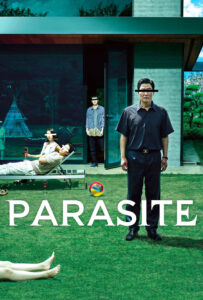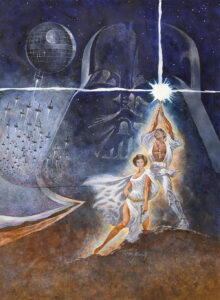Movie poster design combines artistic vision with marketing strategy through composition, color, and typography. Visual storytelling techniques, personal branding, social media integration, and creative strategy shape how these designs continue to captivate viewers and build anticipation for the cinematic experience ahead.
The Role of Visual Storytelling in Film Marketing
Each element of a film poster does a different job: composition guides viewers through the story beats, while color schemes set emotional tones and connect to a broader mood. Typography does more than display text, too — it builds character through carefully selected fonts that reflect genre conventions and time periods.
Hand-painted masterpieces of the golden age gave way to photographic collages in the 1980s, which in turn evolved into the streamlined digital designs common today. Modern movie posters now operate on multiple visual levels, starting with strategic composition and color schemes. For example, the 2019 psychological thriller “Parasite” positioned its central family ascending a staircase—a visual metaphor that gained deeper meaning as the plot unfolded. Paired with a desaturated color palette punctuated by stark shadows, the poster hinted at the film’s dark undertones without revealing its surprises.
Modern posters also incorporate subtle details that reward closer inspection, sparking social media discussions and fan theories that amplify marketing reach. Designers use digital tools to prototype these details rapidly and test them with focus groups before release. Through an iterative approach, marketers can more precisely refine their visual messaging based on audience feedback.
Personal Branding in the Digital Era

Personal brands shape film marketing campaigns through distinct visual identities that connect creators with their audiences. Indie directors craft signature styles for their promotional materials—from poster designs to social media content—creating visual threads that weave through their entire body of work.
Independent filmmakers can use movie posters to build a personal brand and compete in a market dominated by major studios. Creative posters help filmmakers position themselves in a crowded industry and attract viewers who appreciate distinct personal voices. This approach transforms limited resources into marketing strengths through authentic visual storytelling.
Director’s Visual Signatures
Every director has a certain flair they’re known for, and filmmakers like Wes Anderson and Guillermo del Toro are sterling examples of how directorial style shapes marketing materials.
Anderson’s posters mirror his films through centered compositions, pastel color palettes, and Futura typography, while del Toro’s marketing materials embrace gothic imagery, deep crimsons, and ornate Victorian-inspired designs. These visual signatures create instant recognition and a persistent style. Marketing teams carefully preserve these elements across campaigns, knowing audiences connect with and seek out distinctive creative voices.
Independent Film Marketing
Small studios craft marketing strategies around their directors’ unique creative approaches. They emphasize artistic vision through carefully chosen visual elements, typography, and design that reflect the filmmaker’s perspective while staying within budget constraints.
Marketing professionals working with independent films focus on authenticity in their promotional materials. They create campaigns that showcase directorial style through thoughtful design choices, helping small productions find their audience without relying on expensive advertising tactics.
The Influence of Social Media on Film Marketing

Social media platforms give static movie posters a glow-up into dynamic, shareable content. To encourage audience participation, film promoters create poster variations optimized for different social contexts—square formats for Instagram feeds, and vertical designs for TikTok and Stories. Through creative transitions and behind-the-scenes reveals, users transform movie posters into trending video content, while detailed carousel posts spotlight poster artwork.
These organic interactions are meticulously monitored by studios to identify resonant visual elements, building campaigns that bridge traditional marketing with digital engagement. This multi-channel approach amplifies reach while maintaining consistent visual identity across physical and digital spaces.
The Intersection of Art and Marketing
Through simplicity, the “Jaws” poster redefined movie marketing with its arresting image of a shark ascending toward a swimming figure. This minimalist approach influenced decades of thriller campaigns, demonstrating how artistic restraint serves marketing goals. Marketing pros often analyze such landmark campaigns to understand the interplay between visual impact and audience engagement—these are at the core of film marketing.
Painted by Tom Jung, the original “Star Wars” poster balanced artistic ambition with commercial appeal through heroic composition and theatrical style. Marketing teams continue studying its masterful approach to character hierarchy and dramatic lighting, much like they examine “The Social Network’s” stark portrait with bold typography or “Moonlight’s” evocative triptych design. Each artistic choice amplifies marketing effectiveness while preserving creative integrity.
Many modern campaigns draw inspiration from the Polish School of Poster Design, which treated promotional materials as independent artworks rather than literal representations. This artistic freedom manifests in contemporary marketing strategies, where studios commission multiple designs for single films, using marketing data to refine creative approaches. From the striking orange-and-teal palette of “Mad Max: Fury Road” to the distinctive pink branding of “The Grand Budapest Hotel,” successful campaigns demonstrate the power of unified visual elements across all promotional channels.
Lessons for Modern Film Enthusiasts and Marketers

Movie poster design offers rich insights for anyone working with visual marketing materials. Professional designers and marketing teams analyze successful posters to understand how composition guides attention, how color evokes emotion, and how typography reinforces messaging. These visual storytelling techniques apply across industries, from social media content to brand development:
- Study poster hierarchies: Notice where your eye moves first, second, and third across your favorite movie posters. This reveals how designers guide viewer attention through the strategic placement of images and text.
- Consider color relationships: Examine how different color combinations affect the mood of a poster. Note which palettes appear in different genres and how they influence viewer expectations.
- Analyze typography choices: Look at font pairings and sizes in successful posters. Be mindful of how text placement and style complement rather than compete with images.
- Track visual trends: Save posters released in the same year or genre. Compare their approaches to spot emerging design patterns you might adapt for your projects.
Movie posters remain relevant marketing tools because they distill complex narratives into single, memorable images. Whether displayed on theater walls or adapted for social media, these visual assets continue serving their core purpose, which is communicating a film’s promise to potential viewers. As marketing channels expand, poster design adapts—balancing artistic vision with promotional goals while meeting audiences across physical and digital spaces.


